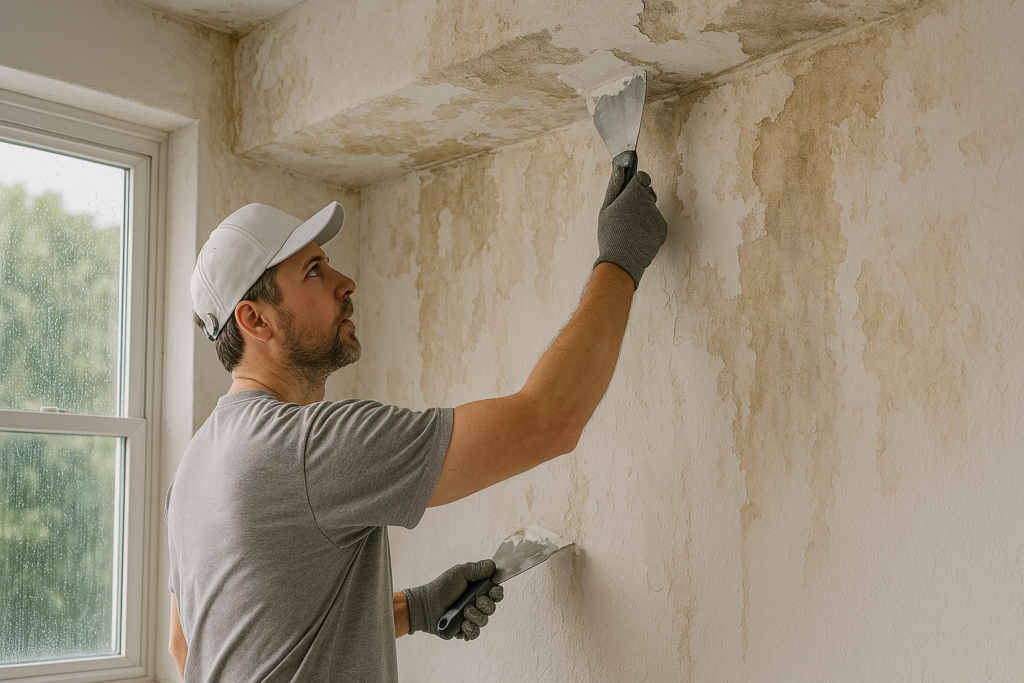Storm season brings heavy rain, strong winds, and the possibility of flooding, all of which can lead to significant water damage to your home. Preparing your home for these conditions is crucial for minimizing damage and ensuring your property remains safe. By following these essential tips, you can effectively protect your home from water damage during storm season.
1. Inspect and Maintain Your Roof
Your roof is the first line of defense against storm damage. Before the storm season arrives, thoroughly inspect your roof for any signs of wear and tear, such as missing or damaged shingles, loose flashing, or debris blocking the drainage systems. Addressing these issues promptly can prevent leaks and water damage. If you’re unsure about your roof’s condition, hire a professional roofer for a complete evaluation and necessary repairs.
2. Keep Gutters and Downspouts Clean
Clogged gutters and downspouts can lead to water overflowing and pooling around your home’s foundation, which can cause severe water damage. Regularly clean your gutters and downspouts, especially before storm season starts. Remove leaves, twigs, and other debris to ensure that water flows freely through the system. Additionally, check that your downspouts direct water at least 3-4 feet away from the foundation to avoid water pooling around your home.
3. Seal Windows and Doors
Windows and doors are common points where water can infiltrate your home. Inspect the seals around your windows and doors for any cracks or gaps. Reapply caulk or weatherstripping as needed to ensure a tight seal. Also, make sure that windows and doors close properly, and there are no visible signs of damage. If necessary, consider installing storm windows or additional weatherproofing to provide extra protection against strong winds and heavy rainfall.
4. Check Your Sump Pump
If your home has a sump pump, it’s crucial to ensure it’s in good working condition before storms arrive. Test the pump by pouring water into the sump pit to check that the pump activates and drains the water effectively. Clean the sump pit to remove debris that might clog the pump. Also, check the pump’s power source to ensure it’s functioning properly. Consider investing in a battery backup system to keep the sump pump operational in case of power outages.
5. Improve Yard Drainage
Proper drainage around your home is essential for preventing water from seeping into your foundation. Make sure the ground slopes away from the foundation to help redirect water. If there are low spots, consider grading the area or installing a French drain system to redirect excess water away from your home. Additionally, ensure that any existing drainage systems, such as surface drains or French drains, are clear and working efficiently.
6. Waterproof Your Basement
Basements are particularly vulnerable to flooding and water damage during storms. Inspect the walls and floors of your basement for any cracks and seal them with a waterproof sealant. If your basement is prone to moisture issues, consider installing a complete waterproofing system or a vapor barrier. Also, keep basement windows closed during storms to prevent water from entering your home.
7. Inspect Plumbing and Pipes
Storms can exacerbate existing plumbing issues, leading to leaks or burst pipes. Inspect the plumbing in your home, particularly in areas like the basement or under sinks, for any signs of wear, leaks, or corrosion. Repair any damaged pipes or fittings promptly to prevent further issues. Also, check the hose connections on appliances such as washing machines or dishwashers and replace any worn or damaged hoses before the storm season begins.
8. Secure Outdoor Items
Outdoor furniture, grills, and other garden tools can be swept up by strong winds, turning them into dangerous projectiles. Secure or store these items before a storm to prevent them from being damaged or causing harm. Bring lightweight items inside and tie down heavier objects to ensure they stay in place during the storm.
9. Prepare for Flooding
If you live in an area prone to flooding, extra precautions should be taken to minimize the risks. Keep sandbags on hand to block any incoming floodwaters from entering your home. Elevate electrical appliances and utilities, such as your furnace and electrical panel, above the expected flood level to reduce damage. Additionally, make sure you have an emergency evacuation plan in place, complete with evacuation routes and emergency contact information.
10. Install a Water Detection System
A water detection system can help you catch leaks and potential flooding before they cause significant damage. Install water sensors in high-risk areas such as under sinks, near appliances, and in the basement. These sensors will alert you to any moisture or leaks, and you’ll be able to address the issue before it worsens.
11. Maintain Your Landscaping
Landscaping can play a crucial role in controlling water flow around your home. Avoid planting trees or shrubs too close to your foundation, as their roots can block proper drainage. Maintain your lawn and garden regularly, and ensure that your irrigation system is functioning properly without creating water accumulation around your home.
12. Review Your Insurance Coverage
Lastly, take the time to review your homeowner’s insurance policy to ensure you have the necessary coverage for storm-related water damage. If you don’t already have flood insurance, consider adding it to your policy. Make sure your policy reflects any recent changes to your home, and update your coverage if needed to protect against potential storm damage.
Preparing your home for storm season requires a combination of regular maintenance, proactive measures, and emergency planning. By inspecting your roof, cleaning gutters, sealing windows, and maintaining plumbing systems, you can minimize the risk of water damage. Additionally, securing outdoor items, preparing for flooding, and reviewing your insurance will help you stay ahead of potential storm-related damage. These steps will ensure you’re ready for whatever the storm season brings.

